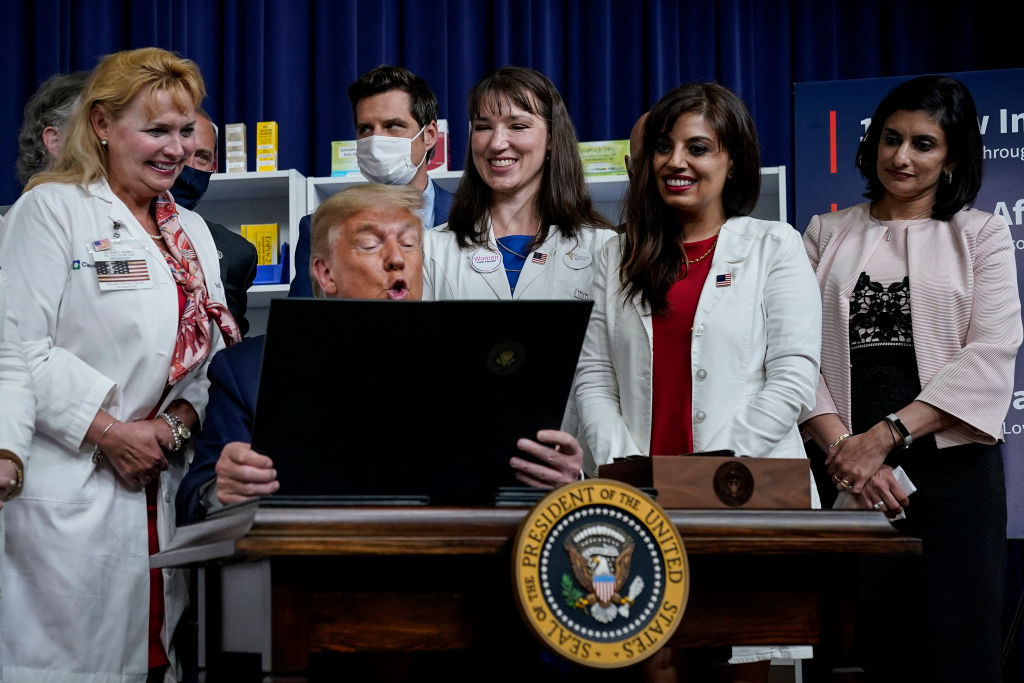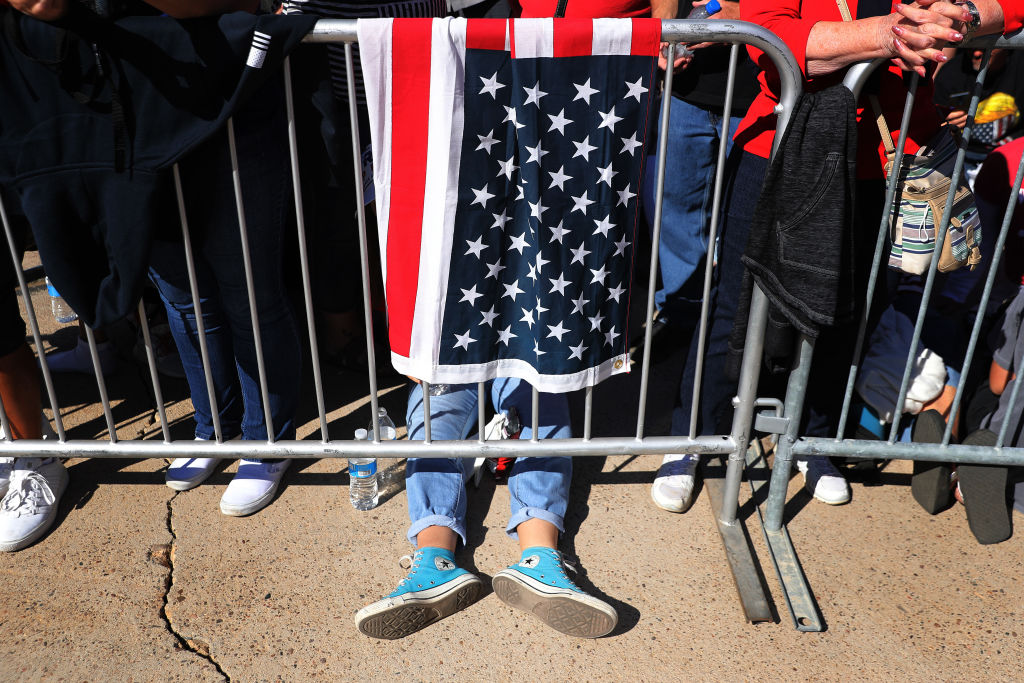As the days to Nov. 3 dwindle down, the president of the United States has been hand selecting his points of emphasis for rallies and Twitter posts. Often, those choices go against the wishes of his own advisers. Veering away from core issues, Donald Trump has repeatedly invoked Hunter Biden’s name, doubled down on unsupported allegations of mail-in ballot vote fraud, suggested he’ll leave the country if he loses the election and repeated debunked claims that masks are not effective in preventing COVID-19.
At most stops, however, Trump has at least attempted to broach one topic that pollsters have repeatedly found to be resonant with voters: the high cost of prescription drugs. And time and again, Trump has not only promised to cut them – “Drug prices will be coming down 80 or 90 percent,” he said during the first presidential debate – but insisted that, functionally, he has already done so.
It’s a strong claim in an election year. Is there hard evidence to support it?
“Evidence exists – but it’s to the contrary,” said Anthony Wright, executive director of Health Access California, a consumer advocacy group. “Drug prices continue to go up and up, and what’s remarkable is how true that is across the board. Newer drugs, older ones, brand names, generics – the prices for all of them are climbing.”
Drug prices in the U.S. rose by 3% from 2018 to 2019, part of a 4.6% overall increase in the cost of medical care.
So say the numbers, Trump’s bluster to the contrary. According to the Bureau of Labor Statistics, drug prices in the U.S. rose by 3% from 2018 to 2019, part of a 4.6% overall increase in the cost of medical care in this country. By July of this year, the prescription cost site GoodRx had recorded an average price hike of nearly 7% among more than 850 brand and generic drugs for 2020.
The issue has an urgency that goes beyond the ballot. In a year of the coronavirus pandemic, with millions of Americans out of work and either absent health insurance or about to be cut from employers’ plans, every hint of a rise in costs feels epic – and continuing increases could be devastating for low and middle income families alike. But even coming into the election cycle, before COVID-19 dominated the conversation, prescription drug prices were near the top of voters’ concerns about health care.
* * *
Nothing about this year has changed that. According to an analysis by the Los Angeles Times, spending on prescription drugs in the first quarter of 2020 was up by nearly 22% over the first quarter of 2017, when Trump took office. And Trump’s administration, with an assist from Senate Republicans and Big Pharma’s powerful lobbying contingent, essentially killed the one measure – a Democratic House resolution – that could have meaningfully pushed back on runaway drug prices.
Perhaps because these realities are unflattering, Trump appears to have chosen to focus on things he has said or directives he has given, ignoring for the moment that a) merely saying things does not give them the force of law, and b) even presidential decrees mean little without a framework to implement them.
Consumer spending on prescription drugs in the first quarter of 2020 was up by nearly 22% over the first quarter of 2017, when Trump took office.
This is not new territory. As a GOP candidate in early 2016, Trump proclaimed that he would empower Medicare officials to negotiate drug prices directly with manufacturers, “So there’s $300 billion [in overpricing] on day one we solve.” The figure, wildly out of line even with Sen. Bernie Sanders’ most optimistic estimate of what direct price negotiating could save, was never explained by Trump’s campaign, and Medicare officials ultimately weren’t enabled to try.
During his tenure in the White House, Trump has returned many times to the theme of lowering drug costs. This summer, with the election bearing down, he signed four executive orders, taking “historic action to deliver lower prescription drug prices to American patients,” according to the Department of Health and Human Services (HHS).
Those orders provide an almost perfect lens through which to view the Trump administration’s approach to the problem of drug pricing. Many words were spoken or written; virtually nothing was actually accomplished.
One of the orders mandated that manufacturer rebates for drugs for Medicare members be sent directly to enrollees, rather than to the managers or health plans that negotiate those discounts. It sounded good – a direct return of money to consumers. The problem: According to the nonpartisan Congressional Budget Office (CBO), the reduction in rebate money going to health managers meant that premiums would rise for Plan D participants, negating for many the entire suggested savings.
Trump boasted that another of his executive orders would reduce the cost of insulin “from big dollars to virtual pennies,” especially for seniors. (“I’m getting it for so cheap it’s like water,” he said during the first debate.) Upon closer inspection, it turned out that the order affected less than 2% of the operations that participate in the federal drug discount program – and of the many rural and low income clinics included, most already offered insulin at reduced or no cost to those below the poverty line. PolitiFact rated Trump’s claim mostly false.
The president also signed an order that would allow Americans to import prescription drugs from Canada, something that his presidential rival, former Vice President Joe Biden, has supported in the past. But not only was it unclear how much savings would be realized once the drugs were repackaged, inspected, relabeled and shipped to the U.S., but both the Canadian government and medical advocacy groups there expressed strong reservations about the idea. There is no guarantee that Canada would ramp up production on Trump’s say-so.
* * *
None of those orders, though, has been touted by Trump as often as the fourth one, a “most favored nation” approach to drug pricing. Put simply, the order calls for the U.S. government to pay drug manufacturers the lowest price for certain drugs that can be found among comparably wealthy countries in Europe and elsewhere. Tweeted Trump, “The days of global freeriding at America’s expense are over and prices are coming down FAST!”
When Trump announced the order in July, he made it clear that it was a gambit to drive Big Pharma to the negotiating table, and the president gave the industry a month to come up with its own plan for reducing prices. The gambit failed: The pharmaceutical companies eventually responded with a toothless proposal to cut prices by 10% for physician-administered drugs in Medicare Part B. It was nowhere close to the favored-nation pricing index idea, which the administration had suggested might shave 30% off prices.
Trump updated his order in September, adding Medicare Part D, which includes most drugs prescribed to seniors. But experts quickly pointed out that the order did not explain what would happen with drugs that aren’t bought by the government, that it left loopholes for HHS to determine which drugs would be included, and that, anyway, Big Pharma would almost certainly sue to prevent its implementation. “We’re a long, long way off from that order leading to anything meaningful in terms of a policy being executed,” said Anthony Wright of Health Access. “We’re at stage one of a multistep process.”
The Elijah E. Cummings Lower Drug Costs Now Act would have accomplished some of Trump’s most often-stated goals. But the measure never had a chance.
If anything, the Trump administration’s tenure may be remembered, however ironically, for one action above all others when it comes to prescription drugs: It smothered the most ambitious plan to curb runaway prices that has been developed since the president took office.
The Democrat-sponsored H.R. 3 was named the Elijah E. Cummings Lower Drug Costs Now Act in honor of the late Maryland congressman, who fought against high drug prices for much of his career. It was an aggressive measure under which HHS would negotiate the prices of a wide range of the most-prescribed drugs in its prescription program. Those prices could not exceed 120% of the average cost for the drug in the United Kingdom, Japan, Australia, France, Canada and Germany, and the bill imposed heavy excise taxes on companies that refused to negotiate. In many ways, it accomplished some of Trump’s most often-stated goals – but it didn’t come from him.
The bill passed through the House by a 230-192 vote, with unanimous Democratic support, in December of 2019. The CBO estimated that H.R. 3 would save the government $456 billion over 10 years. But the measure never had a chance.
Even before the House vote, the White House said that Trump would veto H.R. 3 should it pass the Senate. That, too, was an empty gesture, since Senate Majority Leader Mitch McConnell (R-Ky.) had long since ruled out any action on the bill. “Socialist price controls will do a lot of left wing damage to the health care system,” McConnell told reporters. “And of course we’re not going to be calling up a bill like that.” The bill died in the Senate.
What American voters are left with, when attempting to determine Trump’s record on prescription drugs and pricing, is a lot of chatter and very little to show for it. Trump campaigned in 2016 on the idea of lowering drug costs, but his administration never advanced a real plan to do so. He claimed he was rolling back price hikes in 2018, though that proved to be illusory. And down the stretch here in 2020, he continues a barrage of tweets aimed at convincing the public he is taking on Big Pharma – but the proof is at the pharmacy counter.
“Four years ago, Trump did not have a record to run on,” Wright said. “While some voters saw his talk as bluster, others could feel ambiguous about what he might actually do. Four years later, we have a very clear record of what he hasn’t done – and what he has actively opposed.”
Copyright 2020 Capital & Main
Top photo: Donald Trump signs executive orders on prescription drug prices in the South Court Auditorium at the White House on July 24, 2020 in Washington, DC. Photo by Drew Angerer/Getty Images.





